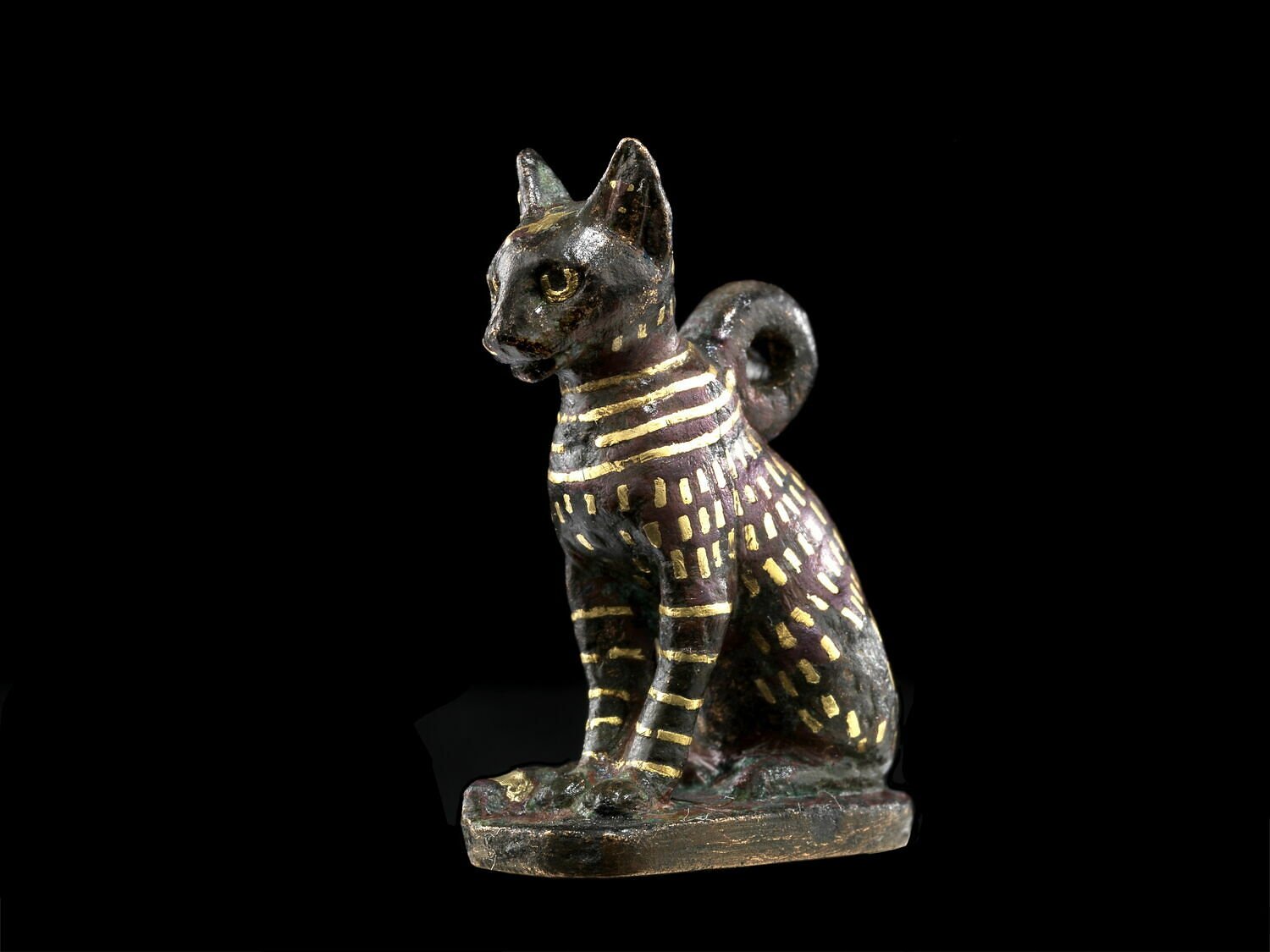The Black Cat:
“Idol of All Witches” or “Black Dragon Floating Above the Clouds”?
Mr. Spock shares The House of Good Fortune’s affection for black cats.
The House is one of many who consider black cats magical creatures. For thousands of years, black cats have been associated with goddesses as well as witches. The gif above is from an episode of Star Trek called “Catspaw,” in which the half Vulcan/half human Mr. Spock is charmed by a black cat, who is actually an evil shape-shifting woman named Sylvia.
Black Cats in Ancient Egypt
The relationship between humans and cats originated from mutual benefit. Cats helped protect human grain stores by hunting the vermin that threatened them, while humans offered a safe environment from larger predators.
Due to their unique blend of independence and their protective nature, the Egyptians saw a divine presence in cats. Bastet, the goddess of both violence and fertility, was often depicted as a human-cat hybrid.
Black was one of Bastet’s sacred colors, and she was frequently portrayed as a black cat. As a result, the black cat was especially revered in Egyptian culture.
Cats were so beloved in ancient Egypt that killing one was considered a grave offense. When a cat passed away, it was lovingly mummified and buried with its human companion, so they could be reunited in the afterlife.
Herodotus, the ancient historian, described the mourning practices when a cat died in Egypt. The inhabitants of a household would shave their eyebrows as a sign of grief, and the cat’s body would be embalmed and placed in a sacred tomb. The mourning period was not considered over until the family’s eyebrows had regrown.
Black Cats in Europe
Europeans did not venerate cats in the same way that Egyptians did. Cats were kept as pets in ancient Greece and Rome, but they were viewed with suspicion due to their nocturnal prowlings and prowess as hunters. But it was the Catholic Church that gave life to the many folk tales and superstitions associating cats with evil. This excerpt from the Wall Street Journal outlines the process by which cats were formally villified:
“When Christianity became the official religion of Rome in 380, the association of cats with paganism and witchcraft made them suspect. Moreover, the cat’s independence suggested a willful rebellion against the teaching of the Bible, which said that Adam had dominion over all the animals. The cat’s reputation worsened during the medieval era, as the Catholic Church battled against heresies and dissent. Fed lurid tales by his inquisitors, in 1233 Pope Gregory IX issued a papal bull, Vox in Rama, which accused heretics of using black cats in their nighttime sex orgies with Lucifer—who was described as half-cat in appearance.
“In Europe, countless numbers of cats were killed in the belief that they could be witches in disguise. In 1484, Pope Innocent VIII fanned the flames of anti-cat prejudice with his papal bull on witchcraft, ‘Summis Desiderantes Affectibus,” which stated that the cat was ‘the devil’s favorite animal and idol of all witches.’”
Yet black cats have long been regarded as symbols of good fortune in Great Britain — perhaps due to the nation’s Protestant roots its citizens were inclined to disregard the Pope’s edicts. Rooted in both folklore and maritime tradition, English sailors believed that a black cat’s presence on a ship would bring good weather and ensure a safe voyage. Sailors often kept black cats aboard their ships, believing they could ward off storms, calm rough seas, and ensure a successful journey. These cats were thought to possess an innate ability to sense danger, serving as early warning signals for unpredictable weather or hidden perils. Their presence was also believed to bring prosperity—if a ship’s black cat was well cared for, it was said that the voyage would be profitable and free from misfortune.
The belief extended to sailors’ families as well. A black cat kept at home was thought to safeguard a seafarer while he was away, ensuring his safe return. In some coastal communities, a cat’s behavior was closely observed; if a black cat appeared restless or distressed, it was taken as a sign that a loved one at sea might be in trouble.
A black cat crossing one’s path was considered a sign of impending good luck rather than bad, an association that can be seen clearly by the black cats portrayed in this collection of postcards. It was also thought that owning a black cat would attract wealth and happiness, and for this reason, gifting a black cat to a bride in the Midlands was a gesture meant to bless her marriage with happiness and abundance.
Superstitions associating black cats with good luck exist in France and Italy also.
The association between witches and black cats is a long-standing one. Images courtesy of The Wellcome Collection.
Black Cats in the United States
In the United States, black cats are often linked to superstition, mystery, and the supernatural—largely due to their historical association with witchcraft and folklore. During the colonial era, particularly in Puritan New England, black cats were believed to be familiars of witches, aiding in spell-casting and carrying out magical mischief. This perception contributed to the lingering superstition that crossing paths with a black cat brings bad luck, a belief that remains common in American popular culture today.
In the African-American tradition of hoodoo, a black cat’s bone is said to be able to make you invisible. The origin of this belief should be obvious to anyone who has played hide -and-seek with a black cat. The method for extracting the bone is rather gruesome (boiling the cat alive), and The House is pleased to report that many modern-day hoodoo practitioners use black cat fur for this purpose rather than a bone. (Note: anyone in need of black cat fur should feel free to reach out to The House, who has an abundant and renewable supply of this resource.)
However, black cats are also celebrated in some circles, particularly around Halloween, where they are iconic symbols of the season’s enchantment and intrigue. In recent years, animal advocates and pet lovers have worked to shift the narrative, emphasizing black cats as loving companions and even symbols of good fortune, much as they are in other cultures.
Black Cats in Japan
It is said that the domestic cat first came to Japan in the sixth century, around the same time as Buddhism, to protect sacred texts from the damage mice can cause. Genetic research indicates that the domestic cat probably came to Japan from India, via China. The first definitive record of a domestic cat in Japan is from 889 in a diary known as the Kanpyō Gyoki kept by the Emperor Uda, who lovingly describes his black cat as follows:
“I wish to express my joy of the cat… the color of the fur is peerless, none could find the words to describe it… I affixed a bow about its neck but it did not remain for long… in rebellion it narrows its eyes and extends its needles… when it lies down it curls into a ball like a coin. You cannot see its feet… when it stands, its cry expresses profound lonliness, like a black dragon floating above the clouds… its color allows it to disappear at night. I am convinced it is superior to all other cats.”
Czech Glass Bead of Black Cat with Green Crystal eyes, House of Good Fortune Collection
The black cat's journey through history is a testament to the complex interplay between culture, superstition, and symbolism. From revered guardians in ancient Egypt to misunderstood figures in medieval Europe, black cats have navigated a path fraught with both veneration and vilification. Today, as we strive to dispel old superstitions, we can appreciate black cats for what they truly are: elegant, mysterious, and affectionate companions. Embracing them not only enriches our lives but also honors a legacy that spans centuries and continents.











